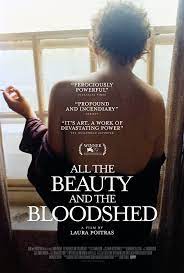
ALL THE BEAUTY AND BLOODSHED
US, 2022, 122 minutes, Colour.
Nan Goldin.
Directed by Laura Poitras.
There is a great deal – more than a great deal – going on in this Oscar-nominated documentary. In fact, it is two films in one, each story commenting on the other.
The focus of the film is photographer Nan Goldin, born 1953. The film traces her career and life with all its ups and downs but also focuses on her establishing P.A.I.N (Prescription Addiction Intervention Now) and her mission in denouncing the industrialists, the Sackler family, and their promotion of opioids leading to a plague of deaths, overdoses, suicides.
Director is Laura Poitras who made documentaries about Julian Assange and Edward Snowden.
The film introduces Nan Goldin as a campaigner from the mid-2010s. So, the tone is set – and, sometimes unexpectedly, the audience is drawn back into her campaign, the range of protests, banners, protesters lying down as if dead, clashes with the police.
But, at the core of the film is the exploration of Nan Goldin herself and her life. She participated fully in the film, interviewed, commentary, action, discussing memories, discussing friends and associates, her career and its success, her own personal difficulties and failures. And, the film incorporates into the narrative at various times selections from her
The title of the film is a reference to Nan Goldin's older sister Barbara Holly Goldin. 'All the beauty and the bloodshed' is a direct quote taken from a psychiatrist's mental health evaluation of Barbara during her time at an institution. Nan Goldin spends a great deal of the film reflecting on her sister, looking at photographs, speculating about her unhappy life, treatment by her incapable parents, her leaving home, fostering, mental collapse, her suicide at the age of 18 and Nan Goldin’s continued admiration for her sister and her grief at her death.
Nan Goldin herself had a hard life, clashes with her parents, leaving home, fostering, discovering her talent for photography. And she belonged to New York after leaving her native Boston. She had her ups and downs in the 1960s, 1970s, 1980s, sometime as a sex worker, her being helped by the proprietor of a diner, Tin Pan Alley, which became a centre for whole range of characters in New York. And this happened at the same time as life at The Factory and Andy Warhol (who is seen in one picture and glimpsed in another but never spoken about – and just mention of Robert Maplethorpe and his photos). However, there was quite a range of characters in Nan Golden Circle, men and women, gay, many film clips of them, and sequences from independent films of New York at the time.
Nan Goldin created a number of slideshow programs, selections of which appear throughout the film, as well as her book and film, The Ballad of Sexual Dependence.
Which means that this portrait of Nan Goldin, photos, the film clips from the avant-garde films from the 1970s and 1980s, and Nan Goldin’s continuous commentary built up a rounded portrait – and, surprisingly at the end, her meeting with her mother and father, talking with them, their seeming to have come to terms with life half a century after the death of their daughter.
And, interspersed with the biographical material are the sequences of protest. Some explanation is given about the Sackler family, some photos, history, the production of medication but, especially in 1996, oxytocin, its over prescription, the dire consequences, even ordinary people having an injury and being recommended the opioid and its seemingly almost instant power of addiction. There are quite a number of talking head testimonies, especially of distraught parents.
One of the important things in the film is that the Sacklers have been extraordinary philanthropists especially in the art world, some of the members having extraordinary collections. So, demonstrations in New York, in London and other parts of the world over the years, including the Louvre, to withdraw the Sackler name, physically, from the museums, a protest on the harmful effect their industry has had as well as the enormous amounts of money that they made.
Later in the film, there is footage of discussions and challenges to members of the family, their being seen listening and responding to the attacks, to the criticisms. And, finally, one of their companies, Purdue, declares bankruptcy but protects the investors. And the family have to give $6 billion to the government. And the comment that this is not nearly enough.
So, the film stands by itself is a portrait of Nan Goldin. But it is also a powerful social protest in the context of the opioid epidemic throughout the US and beyond at the beginning of the 21st-century.
(A fictionalised story of the opioid crisis was dramatised in the 2021 film, Crisis, with Gary Oldman and Armie Hammer.)